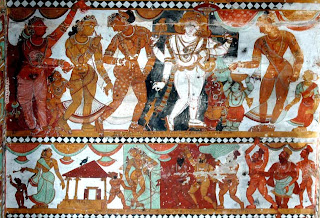The
early school of eastern India has excellent examples in Bihar and Bengal and
the sculptor has excelled in his art. Magnificent images in metal from Kurkihar
and Nalanda proclaim the wealth of imagination and the fine artistic taste of
the early sculptor. The beautiful Taras, Buddhas and scenes from the Master's
life including his descent, his first sermon, subjugation of Nalagiri, the
Avalokitesvaras and other figures of the Buddhist pantheon are master pieces.
The flames of the aureole, the petals of the lotus, the folds of Buddha's
garments, the jatas of Brahma, the crown of Sakra, the peace and charm on the
face of every one of these figures are all characteristic of this school.
The
Pala School of painting very closely follows the great traditions of sculpture.
The earliest manuscripts of this school are on palm-leaf and wooden covers of
manuscripts. There are also some excellent incised drawings on metal like the
famous one from Sundarban in the Asutosh Museum, Calcutta, which are quite
noteworthy. The Pala School of book illustration presents the figures in the
classical tradition and the outline drawings are sinuous, full of vitality and
grace. The paintings that come in the centre with the text on either side
mostly illustrate Buddhist texts like the Prajnaparamita, Gandavyula
Sadhanamala, etc. Iconography is usually the main theme. These pictures follow
the mural traditions and appear just like reduced copies of their originals.
One of the best specimens of an illuminated Prajnaparamita manuscript is dated
in the sixth year of the king Mahipala.
The
Palas and Senas were patrons of art and literature and several beautiful
illuminated manuscripts were produced during their day. This art extended to
Nepal and it was Pala art in this region also. By the thirteenth century, stylization
started in eastern Indian art and it may be easily noticed that the incised
drawing of Vishnu and devotee on metal plate from Sundarban has a marked
affinity with the angular treatment in the western Indian Jain school of
Gujarat.
When
Bihar and Bengal came under Muslim domination in the thirteenth century, the
angular figures resembling the western Indian school in eastern Indian art imbibed
certain Muslim elements in dress and other features and, by the fifteenth
century, the book illustrations on paper from Oudh, Jaunpur and other places
resembled closely the style in Malwa with similar Hindu and Muslim confluence
of ideals.
Similarly
palm-leaf manuscripts were produced in Orissa and Jayadeva's Gitagovinda easily
provided a joyous theme to be lovingly handled. It is from similar angular
representations, to a certain extent influenced by the Vijayanagara School at a
later date, that late manuscripts like the Gitagovinda and the Ramayana from
Orissa, now preserved in the National Museum, were produced.
Writer
– C.Sivaramamurti
Read Also:
Subscribe to:
Post Comments (Atom)













0 Response to "Pala and Medieval Eastern School "
Post a Comment